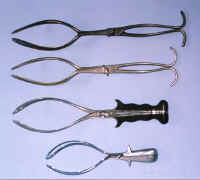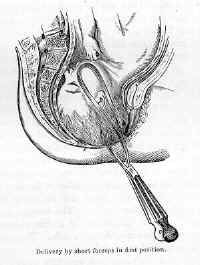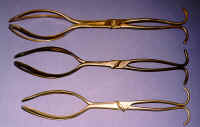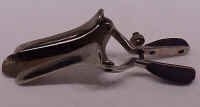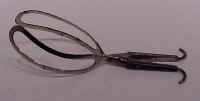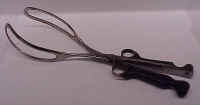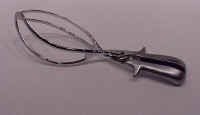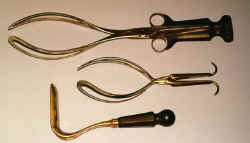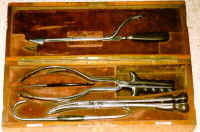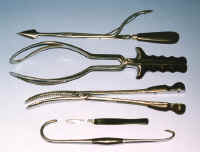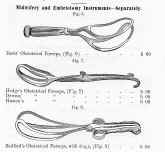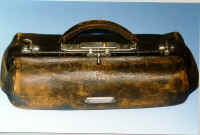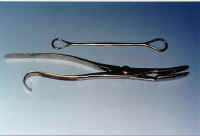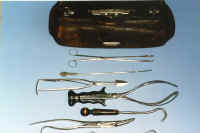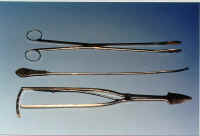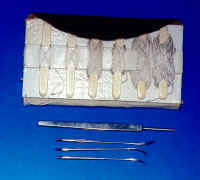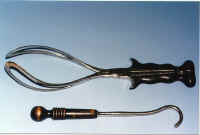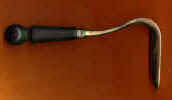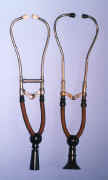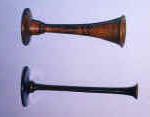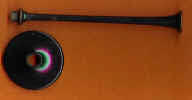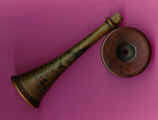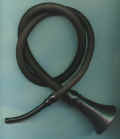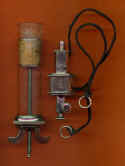Obstetrical and Stethoscopes
In the pre-1900 era, most doctors knew how to deliver a baby, but in practice it seems many were either delivered by lay people or mid-wives. The instruments shown on this page illustrate the more technical side of obstetrical delivery.
Early obstetrical forceps- made of blue gun steel, c.1840; a later example from C.E. Kolbe, Phila. c. 1880; by Sharp and Smith, c. 1895; c.1929 by Sklar, chrome plated type.
Bedford forceps, by Shepard and Dudley c. 1875: note the finger holes on the larger standard size ebony handled forceps and the very small forceps below with ebony handles. The ebony handled speculum is also part of this set. Note: Bedford's forceps were introduced in 1846 by Gunning S. Bedford (1806-1870). He was born in Baltimore and practiced in New York.
Various obstetrical forceps from an 1860 Snowden and Brother catalog as typical of Civil War era instruments. Historical note: Think about this. It's 1880, there is a breech birth, the fetus is deceased, and the mother is in danger of dying. What are the options? There is ether for an anesthetic, but antibiotics and surgical knowledge don't exist to justify a c-section. The obstetric leather bag above was taken to the home of the patient and gave the doctor a way out to save the mother. Brutal times, but necessary.
Due to the presence of rickets in both Europe and the states, it is estimated that about 14% of women at the time could not give natural birth due to a smaller or malformed pelvis. Among populations without that ailment, the problem was almost non-existent due to normal pelvis size.
Instruments of destruction. A complete leather obstetrical case, c. 1880: by Sharp and Smith, included are ebony handled delivery forceps, cranioclast forceps, cranial perforator with arrow head, blunt hook with ebony handle, and other instruments for field delivery. Includes doctor owner's name on letter and receipt. There are several other items in the case such as hand soap, sulfa drugs, suture needles, etc.
Also, an episiotomy suture set with silk sutures and needles found in the carrying bag. Please see the drug case elsewhere on this site which was part of this set for the same doctor.
Obstetrical retractor (speculum) by Shepard and Dudley, c. 1875, plated, brass showing Three way vaginal speculum with ebony handles by A.L. Hernstein, N.Y., c. 1870's Weiss mechanical uterine specula. Plated brass, c. 1890's. Tiemann & Co. vaginal speculum- retracting and expanding types. Plated brass, c. 1890's Pessaries: a set of hard rubber uterine supports, c. 1880, G. Tiemann Co., NY
Historical note: Perhaps due to multiple childbirths, the uterus would prolapse due to weakened or stretched ligaments and cause pressure on the bladder. The pessary was used intra-vaginally to support the uterus in a raised position.
Historical note: The widespread existence of syphilis and gonococcal disease in the Western world during the 1800's could account for the necessity of dilation of the urethra because of scarring and tissue damage from disease. The other reason...prostate gland swelling. As you can imagine, if one had the "problem", relief was an urgent matter. Most "medical" kits contained instruments like the above "sounds" for solving the problem of urinary tract stricture by the process of blunt, progressive dilation. These sounds were also used to locate kidney stones in the bladder.
Conversation tube (hearing aid) c. late 1800's, however, it appears to be very close to the monaural tubular stethoscopes in some catalogs of the period. Unmarked. An anesthetic vaporizer which was placed over the nose and mouth where liquid ether would vaporize from the gauze when inserted in the metal holder. The gauze was stretched back and forth over the insert. One of the earliest anesthesia masks that could be easily sterilized with better control than a simple handkerchief or mask. There was less CO2 contamination than a closed system inhaler. Invented by S.H. Allis of Philadelphia in 1874. c. 1890 A Heurteloup artificial leech, c. ?. Mfg. unknown, but it is a part of the Japanese marked set shown elsewhere on site. The exact items are shown in Edmonson's American Surgical Instruments on page 53 and indicates its manufacture as Gemrig c. 1870. This is a real mystery as Gemrig was an American maker!
Historical note: Bloodletting was practiced from the earliest periods of medical history. It was believed that removing the "bad humors", and blood being a humor, from the body would cure all sorts of maladies. If it worked for humans, then why not animals too? They did bloodlet animals. George Washington was supposedly bled to death by his doctors.

